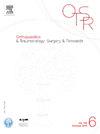What is the clinical detection threshold for lower limb length inequality? In silico study of reproducibility and optimization using a centimeter graduated support
IF 2.3
3区 医学
Q2 ORTHOPEDICS
引用次数: 0
Abstract
Introduction
The threshold of a Leg Length Discrepancy (LLD) by clinical examination on a sheet or centimeter paper (CP) is not known precisely whether or not it concerns limbs equipped with a hip prosthesis. We therefore conducted a prospective in silico study in order to: (1) determine the reproducibility and sensitivity of the clinical measurement of the LLD in different ideal and "degraded" clinical situations, (2) determine the threshold from which the human eye is capable of detecting a length inequality in clinic, (3) to determine whether the use of a graduated support (centimeter paper) improves the clinical measurement threshold.
Hypothesis
Our hypothesis was that clinical measurement on a centimeter support would improve clinical measurement accuracy.
Material and methods
This was an in silico study, the experiment was conducted on a mannequin. Different inequalities were created on a mannequin and photographed with a total of 30 inequalities from −22 to +22 mm on sheet or centimeter paper (CP). This was a multicenter study, with 40 different readers. We asked the readers to make a second measurement one month later. We evaluated the inter- and intra-observer reproducibility. The error rate at the threshold of 3 mm and 5 mm were calculated versus the gold standard. Finally, we determined at which thresholds respectively 75% and 95% of the measurements were correct.
Results
A total of 4140 measurements were performed and compared to the gold standard. With a threshold of 75% accurate measurement, the LLD detection threshold was 2.8 mm on centimeter paper and 4.5 mm on sheet. With a threshold of 95% accurate measurement, the LLD detection threshold was 3.4 mm on centimeter paper and 5.2 mm on sheet. Interobserver agreement (assessed overall on the 40 observers by Krippendorff's generalized Kappa) was 0.86 (95% confidence interval (CI95%) = 0.79 to 0.92) on CP and 0.71 (CI95% = 0.63 to 0.79) on sheet. Intra-observer agreement assessed by the intraclass correlation coefficient among observers who made 2 measurements had a median value (IQR) of 0.96 (0.94 to 0.99) on CP and 0.90 (0.83 to 0.94) on sheet.
Discussion
The clinical detection threshold on sheet at the patient's bed appears close to 5 mm. A more precise measurement is possible with graduated centimeter paper. A study in daily practice on patients in real situations would confirm our results.
Level of evidence
III; prospective diagnostic comparative in Silico study.
下肢长度不等的临床检测阈值是多少?使用厘米级支架对可重复性和优化性进行硅学研究。
导言:目前还不清楚临床检查在厘米纸(CP)上得出的腿长不一致(LLD)阈值是否与装有髋关节假体的肢体有关。因此,我们进行了一项前瞻性硅学研究,目的是(1)确定在不同的理想和 "退化 "临床情况下临床测量 LLD 的重现性和灵敏度;(2)确定人眼在临床上能够检测到长度不等的阈值;(3)确定使用刻度支撑物(厘米纸)是否能提高临床测量阈值:我们的假设是,在厘米支撑物上进行临床测量将提高临床测量的准确性:这是一项模拟研究,实验在人体模型上进行。在人体模型上创建了不同的不等式,并在纸张或厘米纸(CP)上拍摄了-22 至 +22 毫米共 30 个不等式。这是一项多中心研究,有 40 位不同的读者。我们要求读者在一个月后进行第二次测量。我们评估了观察者之间和观察者内部的再现性。计算了 3 毫米和 5 毫米阈值的误差率与金标准的对比。最后,我们确定了在哪个阈值下分别有 75% 和 95% 的测量结果是正确的:结果:共进行了 4140 次测量,并与金标准进行了比较。在测量准确率为 75% 的阈值下,LLD 检测阈值在厘米纸上为 2.8 毫米,在薄纸上为 4.5 毫米。如果测量精确度的阈值为 95%,则 LLD 检测阈值在厘米纸上为 3.4 毫米,在纸张上为 5.2 毫米。观察者之间的一致性(通过克里彭多夫广义卡帕对 40 名观察者进行整体评估)在 CP 上为 0.86(95% 置信区间 (CI95%) = 0.79 至 0.92),在纸张上为 0.71(CI95% = 0.63 至 0.79)。在进行了两次测量的观察者之间,通过类内相关系数评估的观察者内部一致性的中位值(IQR)为:CP 0.96(0.94 至 0.99),床单 0.90(0.83 至 0.94):讨论:病人床上床单的临床检测阈值接近 5 毫米。使用刻度厘米纸可以进行更精确的测量。在实际情况下对患者进行日常实践研究将证实我们的结果:证据等级:III;前瞻性诊断比较研究。
本文章由计算机程序翻译,如有差异,请以英文原文为准。
求助全文
约1分钟内获得全文
求助全文
来源期刊
CiteScore
5.10
自引率
26.10%
发文量
329
审稿时长
12.5 weeks
期刊介绍:
Orthopaedics & Traumatology: Surgery & Research (OTSR) publishes original scientific work in English related to all domains of orthopaedics. Original articles, Reviews, Technical notes and Concise follow-up of a former OTSR study are published in English in electronic form only and indexed in the main international databases.

 求助内容:
求助内容: 应助结果提醒方式:
应助结果提醒方式:


